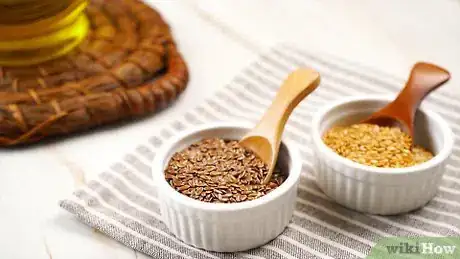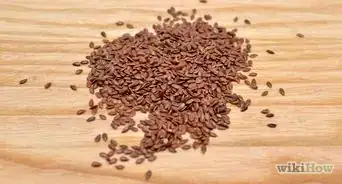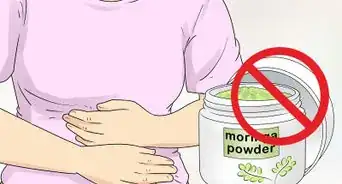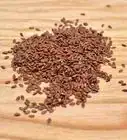This article was co-authored by Claudia Carberry, RD, MS. Claudia Carberry is a Registered Dietitian specializing in kidney transplants and counseling patients for weight loss at the University of Arkansas for Medical Sciences. She is a member of the Arkansas Academy of Nutrition and Dietetics. Claudia received her MS in Nutrition from the University of Tennessee Knoxville in 2010.
wikiHow marks an article as reader-approved once it receives enough positive feedback. In this case, 100% of readers who voted found the article helpful, earning it our reader-approved status.
This article has been viewed 140,997 times.
Flaxseed oil contains omega-3 and omega-6 fatty acids. Both of these are needed for health because they are polyunsaturated fatty acids, or PUFAs. Flaxseed oil also contains other essential fatty acids, such as alpha-linolenic acid (ALA), and omega-9, which can reduce the risk of cardiovascular disease and stroke.[1] Taking flaxseed oil can help to ensure that you get enough omega-3 fatty acids, which have been shown to reduce inflammation, decrease cholesterol levels and help prevent chronic diseases such as heart disease, diabetes, and arthritis. There are different ways to take flaxseed oil, from taking capsules, to drinking the oil, to adding whole flaxseeds to food. Learn more about different ways to take flaxseed oil so that you can begin to incorporate it into your diet.
Steps
Taking Flaxseed Oil
-
1Talk to your doctor about taking flaxseed oil. It is important to ask your doctor about adding flaxseed oil to your diet, especially if you are taking certain medications. Flaxseed oil may interact with some medications including blood thinners, cholesterol-lowering statins, and diabetes medications.
- Always tell your physician about all medications and supplements that you are taking.
-
2Follow the manufacturer’s instructions. The flaxseed oil product that you buy should include instructions about how much and how often to take flaxseed oil. Read and follow the package for specific instructions on how to take the flaxseed oil.
- 1 tablespoon of flaxseed oil taken up to three times per day is a common dosage, but make sure that you check the package of your flaxseed oil to be sure.
- Flaxseed oil taken in excess can cause oily skin, breakouts, and even oily stools.
Advertisement -
3Combine flaxseed oil with juice, water, or tea. If you are not a great fan of the taste, mix with water, green tea or fruit juice — since it is an oil, it won’t mix very well, but if taste is a problem, mixing it will help. It can also help to take liquid flaxseed oil along with a meal or at least a snack to get rid of any aftertaste from taking the oil.
-
4Consider taking flaxseed oil in capsule form. Flaxseed oil is also available in a capsule form. Again, follow the manufacturer’s instructions for how to take the flaxseed oil. Take the flaxseed oil capsules with a full glass of water.[2]
-
5Store flaxseed oil or capsules in the refrigerator. Keep your flaxseed oil capsules or flaxseed oil in the refrigerator in a sealed glass container. Oils can react in air and become rancid, but storing your flaxseed in the refrigerator will help to prolong its life.
-
6Add flaxseed to food after it is already cooked. Flaxseed oil should not be heated. Heating the oil destroys much of its nutritional benefits.[3] If you are adding flaxseed oil to your meals, make sure that you add it after cooking your food. Drizzle flaxseed oil on top of food rather than using it to cook your food.
-
7Cut back if you start to experience gastrointestinal side effects. Flaxseed oil may cause some gas, diarrhea, and/or bloating when you first start taking it. For most people, the gas and/or bloating stops after one to two weeks of use. If you notice any side effects from taking flaxseed oil, cut down on your doses for a while.[4]
Taking Whole Flaxseeds
-
1Buy high quality flaxseeds. There are two different varieties of flaxseeds: brown and golden. The price is often significantly different, but the amount of nutrients is about the same. Choose the seed type that is within your price range and that works best for how you plan to use them.
-
2Grind flaxseeds with a coffee grinder or food processor. If you decide to use whole flaxseeds, but you also want to grind them to add to various foods, then you can use a coffee grinder to grind them up. Make sure that you set aside a coffee grinder that is only for grinding flaxseeds. Otherwise, your flaxseeds may end up getting mixed with coffee grounds.[5]
- Some dietitians recommend ground over whole flaxseeds because it is easier for your body to digest and use the nutrients in ground flaxseed.[6] Whole flaxseeds tend to be excreted from the body still in tact, thus limiting their benefit.
-
3Add whole flaxseeds to food. You can add up to one tablespoon a day of whole flaxseed your food. Add flaxseeds to cereals, soups, stews, sauces, and salad dressings. You can take the tablespoon all at once (in a morning cereal, for example) or divide it up throughout the day.
-
4Sprinkle ground flaxseeds on food. You can also grind flaxseeds and use the ground flaxseed as toppings for cereals, soups, salads, vegetables and stews. Use ½ to one tablespoon of ground flaxseed every day. You can either use it all at once at one meal or divide it up between meals.[7]
- You can also use the freshly ground flaxseeds as a flour to make muffins, pancakes and breads. Substitute the ground flaxseeds for regular flour— if the recipe calls for one cup of flour, add ½ cup of flour and ½ cup of ground flaxseed.
Expert Q&A
Did you know you can get expert answers for this article?
Unlock expert answers by supporting wikiHow
-
QuestionWhat does flaxseed oil do to your body?
 Claudia Carberry, RD, MSClaudia Carberry is a Registered Dietitian specializing in kidney transplants and counseling patients for weight loss at the University of Arkansas for Medical Sciences. She is a member of the Arkansas Academy of Nutrition and Dietetics. Claudia received her MS in Nutrition from the University of Tennessee Knoxville in 2010.
Claudia Carberry, RD, MSClaudia Carberry is a Registered Dietitian specializing in kidney transplants and counseling patients for weight loss at the University of Arkansas for Medical Sciences. She is a member of the Arkansas Academy of Nutrition and Dietetics. Claudia received her MS in Nutrition from the University of Tennessee Knoxville in 2010.
Master's Degree, Nutrition, University of Tennessee Knoxville Master's Degree, Nutrition, University of Tennessee KnoxvilleExpert Answer
Master's Degree, Nutrition, University of Tennessee KnoxvilleExpert Answer -
QuestionWhat are the side effects of flaxseed oil?
 Claudia Carberry, RD, MSClaudia Carberry is a Registered Dietitian specializing in kidney transplants and counseling patients for weight loss at the University of Arkansas for Medical Sciences. She is a member of the Arkansas Academy of Nutrition and Dietetics. Claudia received her MS in Nutrition from the University of Tennessee Knoxville in 2010.
Claudia Carberry, RD, MSClaudia Carberry is a Registered Dietitian specializing in kidney transplants and counseling patients for weight loss at the University of Arkansas for Medical Sciences. She is a member of the Arkansas Academy of Nutrition and Dietetics. Claudia received her MS in Nutrition from the University of Tennessee Knoxville in 2010.
Master's Degree, Nutrition, University of Tennessee Knoxville Master's Degree, Nutrition, University of Tennessee KnoxvilleExpert Answer
Master's Degree, Nutrition, University of Tennessee KnoxvilleExpert Answer -
QuestionHow long does flax oil last in the refrigerator?
 Claudia Carberry, RD, MSClaudia Carberry is a Registered Dietitian specializing in kidney transplants and counseling patients for weight loss at the University of Arkansas for Medical Sciences. She is a member of the Arkansas Academy of Nutrition and Dietetics. Claudia received her MS in Nutrition from the University of Tennessee Knoxville in 2010.
Claudia Carberry, RD, MSClaudia Carberry is a Registered Dietitian specializing in kidney transplants and counseling patients for weight loss at the University of Arkansas for Medical Sciences. She is a member of the Arkansas Academy of Nutrition and Dietetics. Claudia received her MS in Nutrition from the University of Tennessee Knoxville in 2010.
Master's Degree, Nutrition, University of Tennessee Knoxville Master's Degree, Nutrition, University of Tennessee KnoxvilleExpert Answer
Master's Degree, Nutrition, University of Tennessee KnoxvilleExpert Answer
Warnings
- Once you have learned how to take flax oil, don't substitute it in place of essential foods. You still need to eat a healthy diet that includes fruits, vegetables and other sources of antioxidants and omega fatty acids.⧼thumbs_response⧽
- Don't skip doses or go days without taking flax oil once you start a regimen. Omega oils build up in your system when taken regularly, which results in healthful benefits.⧼thumbs_response⧽
- Never take flax oil in place of medications or assume that it will correct medical issues such as high levels of LDL or bad cholesterol. Always consult with a medical doctor to rule out serious health problems or to properly treat them.⧼thumbs_response⧽
References
- ↑ http://www.uccs.edu/Documents/healthcircle/pnc/health-topics/Omega-3_6_and_9_Fats.pdf
- ↑ http://www.mayoclinic.org/drugs-supplements/flaxseed-and-flaxseed-oil/dosing/hrb-20059416
- ↑ https://www.mountsinai.org/health-library/supplement/flaxseed-oil
- ↑ http://www.mayoclinic.org/drugs-supplements/flaxseed-and-flaxseed-oil/dosing/hrb-20059416
- ↑ https://www.unlockfood.ca/en/Articles/Fibre/Find-out-about-flax-seeds.aspx
- ↑ https://www.unlockfood.ca/en/Articles/Fibre/Find-out-about-flax-seeds.aspx
- ↑ http://www.mayoclinic.org/healthy-lifestyle/nutrition-and-healthy-eating/expert-answers/flaxseed/faq-20058354
About This Article
Before taking flax oil, talk to your doctor, since flax oil can interact with some medications, like blood thinners. If your doctor gives you the go-ahead, follow the instructions on the flax seed oil product, such as 1 tablespoon of oil 3 times a day. In order to make it taste better, mix the oil with fruit juice or green tea when you take it. Alternatively, try flax seed oil capsules, which you can swallow with a glass of water. Make sure to store your flax seed oil in the refrigerator, since leaving it out can cause it to go rancid. You should also cut down on your dose if you notice any side effects, such as gas or diarrhea. For more tips from our Dietary co-author, including how to mix flax seed oil with cooked food, keep reading!




































































